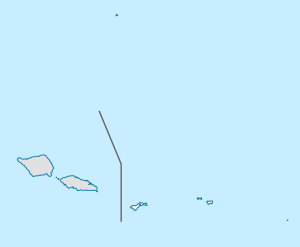Vaitogi
| Vaitogi | |
|---|---|
| Village | |
 Vaitogi | |
| Coordinates: 14°21′S 170°44′W / 14.350°S 170.733°W | |
| Country |
|
| Territory |
|
| Area | |
| • Total | 1.25 sq mi (03.25 km2) |
| Population (2012) | |
| • Total | 936 |
| • Density | 750/sq mi (290/km2) |
Vaitogi is a village in American Samoa. It has many missionaries and tourists who are attracted by the shopping for local products. Vaitogi might be most famous of its legends about the Turtle and Shark (Laumei ma Malie). It is said that once, at a time when food was scarce, an old woman took her granddaughter to the bluff at Vaitogi, and holding hands, they leapt into the sea down below. While the young girl was transformed into a shark, the blind grandmother became a turtle.[1] It gives its name to a local U-shaped cove in town, which was listed on the U.S. National Register of Historic Places in 2014.
Vaitogi was home to 1,347 residents at the 2000 U.S. Census, where 35.1% of residents were foreign-born.[2]
It is home to Tessarea Vaitogi Inn, which is a hotel in town.[3][4]
Fogama’a Crater Trail is a 3-mile roundtrip hiking trail in Vaitogi. The trail goes by two scenic beaches before ending at the junction with the Fagatele Bay National Marine Sanctuary Trail.[5]
History
Vaitogi was visited by Robert J. Maxwell in 1965-1966, who sampled 52 participants in a 22-month research project inspired by the theories of Hans Eysenck concerning Extraversion and introversion behavior.[6]
Vaitogi villagers gather once every year to commemorate an incident that happened over a century ago. At one point, a fire raged through the village for days and could not be extinguished, threatening lives and destroying scores of acres of vegetation and crops. After the village chiefs gathered to pray for the fires to end, heavy rain supposedly fell extinguishing the flames. The village observes a 24 hour curfew once per year to mark the event.[7]
Margaret Mead
Archaeologist Margaret Mead stayed in Pago Pago for six weeks when she studied the Samoan language. She later spent ten days in Vaitogi as the guest of the local chief in town. The chief and villagers treated her like royalty, and provided her with a bed made of twenty woven mats topped with a blanket and sheets. The villagers also gave her information and access to elders in distant villages.[8] She was on the island of Tutuila for a total of two months. Vaitogi was Mead’s favorite Samoan village, and she wrote to a friend: “Here they love me and I love them”.[9]
She also described her stay: “It was there [in Vaitogi] I had all my essential training in how to manage Samoan etiquette… I learned to eat and enjoy Samoan food and to feel unabashed when, as a guest, I was served first and the whole family sat about sedately waiting for me to finish so that they, in turn, could eat… Day by day I grew easier in the language, sat more correctly… I learned how to relate to other people in terms of their rank and how to reply in terms of the rank they accorded me."[10]
Notable people
- Tofilau Eti Alesana, prime minister of Samoa, the longest serving head of a state in the Pacific Ocean.[11][12]
- Mike Iupati, American football guard for the Arizona Cardinals of the NFL.
- Sau Ueligiton, artist, lived in Vaitogi for 25 years.[13]
References
- ↑ Stanley, David (2004). Moon Handbooks South Pacific. Moon Handbooks. Page 480. ISBN 9781566914116.
- ↑ Census of population and housing (2000): American Samoa Summary Social, Economic, and Housing Characteristics (2000). DIANE Publishing. Page 53. ISBN 9781428985490.
- ↑ National Geographic Society (2001). National Geographic Guide to the National Parks of the United States. Page 215. ISBN 9780792270287.
- ↑ Oswald, Michael Joseph (2017). Your Guide to the National Parks: The Complete Guide to All 59 National Parks. Stone Road Press. Page 714. ISBN 9781621280682.
- ↑ https://www.nps.gov/npsa/planyourvisit/upload/Day_Hikes_SB.pdf
- ↑ Holmes, Lowell D. (1988). Quest for the Real Samoa: The Mead-Freeman Controversy and Beyond. Greenwood Publishing Group. Page 134. ISBN 9780897891622.
- ↑ http://www.radionz.co.nz/international/pacific-news/179342/american-samoa-village-observes-annual-24-hour-closure
- ↑ Mark, Joan (1999). Margaret Mead: Coming of Age in America. Oxford University Press. Pages 10, 30 and 35. ISBN 9780190283490.
- ↑ Shankman, Paul (2009). The Trashing of Margaret Mead: Anatomy of an Anthropological Controversy. University of Wisconsin Press. Page 99. ISBN 9780299234539.
- ↑ Shankman, Paul (2009). The Trashing of Margaret Mead: Anatomy of an Anthropological Controversy. University of Wisconsin Press. Pages 91-92. ISBN 9780299234539.
- ↑ Craig, Robert D. (2002). Historical Dictionary of Polynesia. Scarecrow Press. Pages 14-15. ISBN 9780810842373.
- ↑ Lal, Brij V. and Kate Fortune (2000). The Pacific Islands: An Encyclopedia, Volume 1. University of Hawaii Press. Page 288. ISBN 9780824822651.
- ↑ Sutter, Frederic Koehler (1989). The Samoans: A Global Family. University of Hawaii Press. Page 210. ISBN 9780824812386.